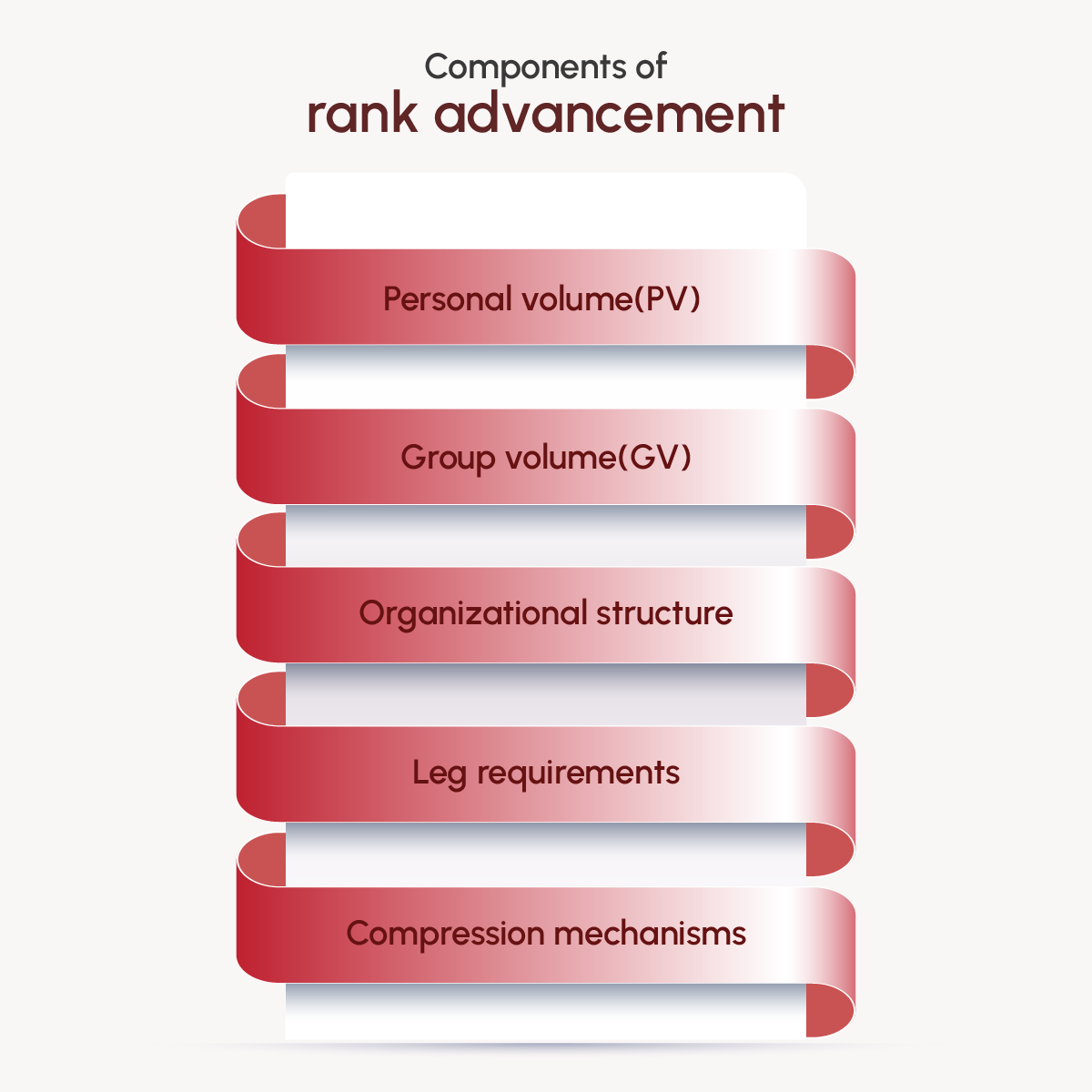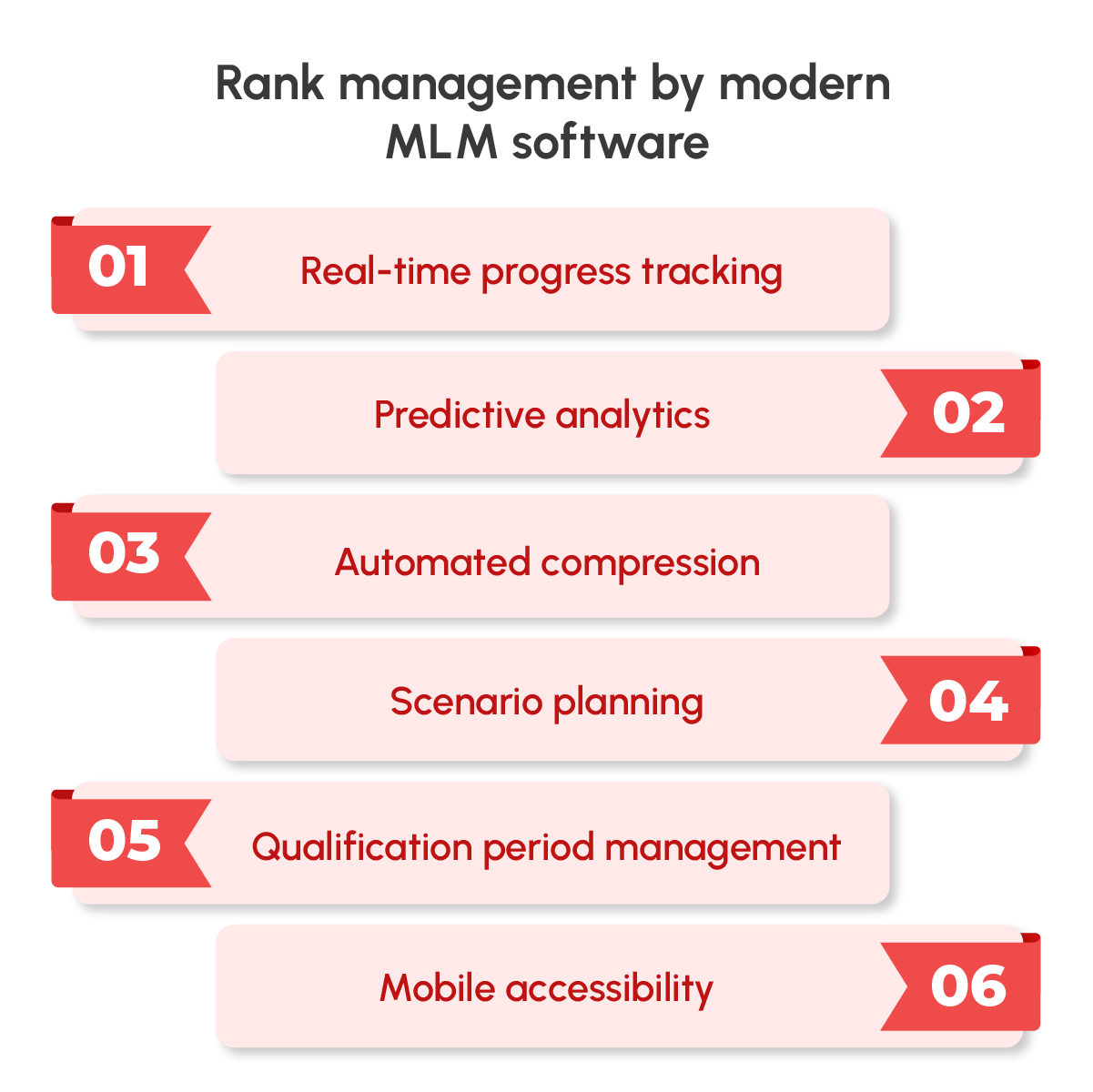“The most innovative companies are reimagining rank advancement as not just a compensation tool but as a comprehensive business development framework,”
– Sophia Williams
In any kind of multi-level marketing business, climbing the ladder of success will be your ultimate goal. To operate successfully in direct selling, professionals need to fully understand rank advancement systems. This is very crucial because it serves as the fundamental structure of your compensation plans. Every compensation plan relies on rank advancement structures since they dictate both present earnings and establish your path to success.
Modern MLM software has been equipped with the latest technologies, which can entirely transform the rank management systems. Let’s go through the basics first.
The foundation of rank advancement systems
The process of rank advancement grants contributors two significant benefits. One, it rewards them for their repeated strategic accomplishments. Two, it aids them in their team development efforts. This, in turn, helps for an overall systematic development. The distributors who only concentrate on current commission rates fail to realize that emerging through different ranks allows their earnings to multiply significantly as they progress.
Sophisticated multi-level marketing businesses construct rank requirements that unite personal sales output with development of their network structure. It is very clear that corporate advancement requires distributors to balance individual commission goals with team building advancements. This is the most strategic way to develop sustainable business systems. Moreover, rank advancements in MLM are closely tied to bonuses, commissions, and incentives, offering distributors higher earning capacity as they rise further up the structure.
The mathematics behind rank advancement

The ranks in advanced compensation models demonstrate particular organizational indicators. This helps with crucial business achievements through quantitative calculations. Knowledge of these calculations grants distributors smart strategies for their business development objectives.
Advanced compensation plans use different metrics to determine rank advancement, which primarily consist of the following.
Personal Volume (PV)
This shows your own personal sales activity by evaluating points or dollar amounts as opposed to real product units. The majority of compensation arrangements demand stable PV thresholds to be maintained throughout each month at every rank level.
Group Volume (GV)
It sums up both your personal sales numbers and all actions of individuals you have sponsored into your network. Higher positions in the company need substantial steps up in GV volume requirements.
Organizational structure requirements
This outlines how to spread volume contributions throughout the company. The company establishes a rule that reduces qualifying volume to 60% from any one segment of your downline structure.
Leg requirements
This mandates specific requirements regarding the number of independent downline organizations, which must be directly sponsored by distributors to advance to each new rank level. Organizations expect multiple sub-organizations at specified achievements levels for advanced rank qualification.
Compression mechanisms
This technology rolls up unattended downline volume to increase qualification efficiency, when represented team members become inactive.
The right kind of interaction between compensation, qualification requirements, and menu plans produce unique growth patterns for each company. Strategic distributors employ these concepts to reach higher rank levels at their distributorship.
How does the rank design work?
Advanced psychological principles build motivation in distributor advancement systems for every step of their journey. Successful businesses place thresholds at proper levels to offer achievable challenges. This promotes distributor commitment and prevents discouragement.
Many organizations implement psychological strategies through time-based rank advancement bonuses and recognition systems, which grow based on progress and incentive structures. All these components align to sustain distributor engagement during the time between significant achievements in rank position.
Crossing the advancement plateaus
“True business success depends on distributors who pass through rank plateaus because they recognize that progression demands both sustaining current efforts and redoing their business approach.”
– Thomas Richards
All distributors will inevitably reach advancement plateaus, which prevents their traditional strategies from achieving further rank development. As a resolution, these natural transition points at plateaus need advanced leadership strategies.
In fact, the majority of distributor plateaus emerge when people move past producing personal sales success into developing next-generation leaders. When distributors achieve success, they need to transition from personal performance optimization to the creation of structures that optimize team success levels.
How does modern MLM software transform rank management?

Advanced MLM software platforms transform rank advancement control at both company levels and distributor levels. These platforms bring exceptional visibility to distributors and companies through their access to qualification processes.
Real-time qualification tracking
Contemporary MLM software platforms display constant qualification metrics, which reveal how much volume distributors need in their specified legs to move up to the next rank.
Predictive analytics
The latest systems use predictive models for anticipating rank advancement based on present growth patterns. Therefore, distributors can prevent qualification-disrupting shortfalls in advance.
Automated compression algorithms
The software processes advanced compression calculations very quickly. Effective software compression makes sure commissions are paid fairly, even when some distributors have gone inactive. This maximizes distributors' earning capacity based on collective company volumes, without labor-based tracking methods.
Scenario planning tools
The software also has feature simulation abilities. This lets distributors evaluate different recruitment and sales tactics to see how their decisions affect the duration until ranking advancements occur.
Qualification period management
The system ensures automatic tracking of qualification periods along with anniversary dates. This allows detection of grace period provisions, which human beings could forget.
Mobile accessibility
The platform provides real-time monitoring across mobile applications. As a result, distributors achieve business management capabilities that enable them to make immediate strategic shifts for their operations.
Integration with recognition systems
The platforms integrate recognition systems to automatically generate announcements, awards, and incentive qualifications when rank advancement occurs.
Top trends for the future

The approach to rank advancement systems evolves when companies respond to market dynamics and changing requirements from their distributors. Modern development in the industry has brought forward several emerging trends which now transform systems operations. Some of these are mentioned below.
Hybrid qualification options:
Companies with progressive management now provide distributors with a range of alternative qualification options. This lets them reach the same rank position through unique pathways that preserve balance requirements.
Sustainable achievement models
This represents improved qualification methods because they track "lifetime achievement" elements to recognize accomplishments that may precede current activities.
Global unification structures
Worldwide organizations are creating interlinked rank structures. This supports market needs in diverse regions without compromising advancement opportunities for their personnel.
Value-based metrics
Several innovative firms now use value-based metrics that include customer retention rates, product diversity metrics, and team stability factors to determine ranking qualifications.
Discover how we build resilient businesses with advanced MLM functionalities
Strategic implementation for modern distributors
For distributors who want to reach their maximum potential advancement, there are multiple strategic methods:
- They should convert the guidelines for rank advancement into daily objectives, which allow both tracking and successful implementation throughout the term.
- Organizations should create specific training solutions that prepare distributors for moving between rank levels by teaching necessary skills for progression.
- Your organization should implement systematic ranking methods that link employee targets to essential steps for obtaining higher positions.
- Your organization should develop structured documentation of effective rank advancement methods, which function as standardized practices throughout all units.
- Rank advancement timeline projections should function as both recruitment tools and retention measures because they show members exactly how to advance toward success.
The distributors who treat rank advancement as a strategic discipline rather than a peripheral benefit position themselves for sustainable success.
The basic principles for achieving effective rank advancement in direct selling will remain constant—aligning activities with advancement metrics while building balanced organizational structures. This also includes using technology for strategic decision-making. People who learn to use these essentials create advancement success that delivers their best competitive edge.









Leave your comment
Fill up and remark your valuable comment.